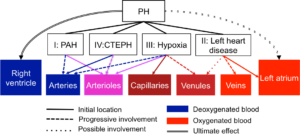Pulmonary Hypertension
Team: 1Michelle Bartolo, 1Amanda Colunga, 1Mansoor Haider, 1Mette Olufsen, 2Megan Chambers, 3Naomi Chesler, 4Nicholas Hill
Affiliations: 1NC State University, 2Virginia Military Institute,3UC Irvine, 4University of Glasgow
Recent Publications:
- Numerical predictions of shear stress and cyclic stretch in pulmonary hypertension due to left heart failure
M Bartolo, MU Qureshi, M Colebank, N Chesler, MS Olufsen
Biomechanics and Modeling in Mechanobiology, 2022 - A multiscale model of vascular function in chronic thromboembolic pulmonary hypertension
M Colebank, MU Qureshi, S Rajagopal, R Krasuski, MS Olufsen
Integrative Cardiovascular Physiology and Pathophysiology, 2022 - Structural and hemodynamic properties in murine pulmonary arterial networks under hypoxia-induced pulmonary hypertension
M Chambers, M Colebank, MU Qureshi, R Clipp, MS Olufsen
Journal of Engineering in Medicine, 2020
Overview:
Pulmonary hypertension (PH) is defined by an elevated blood pressure in the pulmonary arteries, leading to right ventricular dysfunction and alterations in typical oxygen exchange in the lungs. There are five main etiologies of PH, including PH due to left heart impairment (group II), PH due to lung disease, such as COPD and hypoxia (group III), and chronic thromboembolic PH (group IV). PH leads to remodeling in large and small arteries as well as arterioles, which changes both the structure and function of the pulmonary vasculature. Using mathematical modeling, our group investigates how both local and systems-level changes in hemodynamic parameters impact pressure, cardiac output, and heart function in patients with PH. Our long-term goal is to use mathematical modeling to monitor disease progression in PH patients in a non-invasive manner and further understand the underlying disease mechanism.

Video:
Click here to watch an overview!
Click here to return to our general research page!
